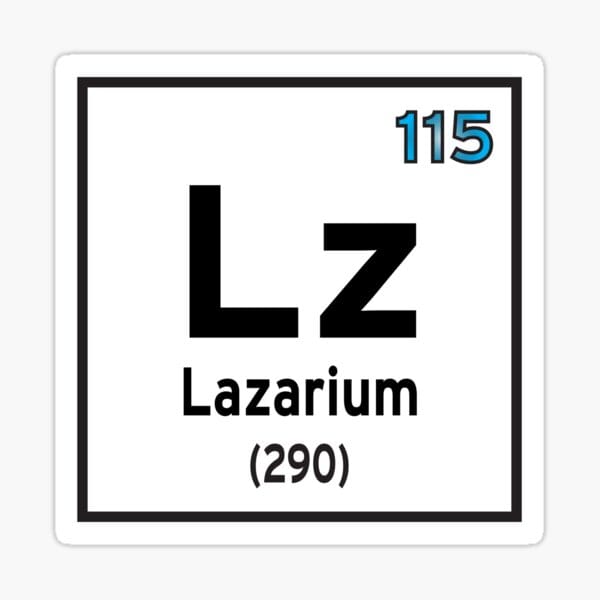Dive into the captivating world of element 115, also known as Lazarium or its official name, Moscovium. Often whispered about in science fiction and shrouded in mystery, Moscovium walks the line between scientific reality and fantastical speculation. Join us as we unravel the truth about this intriguing element, separating fact from fiction while exploring its properties, its potential, and what it reveals about the universe’s most fundamental building blocks.
Unmasking Moscovium: From Sci-Fi to Reality
Element 115, now officially named Moscovium, has long captivated imaginations, appearing in science fiction tales and sparking endless debates among UFO enthusiasts. Yet, its existence is firmly rooted in the realm of science.
Discovered in 2003 by a joint team of Russian and American scientists at the Joint Institute for Nuclear Research (JINR) in Dubna, Russia, Moscovium is a synthetically produced element, meaning it does not occur naturally on Earth. Instead, it’s created by bombarding atoms of Americium-243 with ions of Calcium-48 in a particle accelerator.
What makes Moscovium especially intriguing, and incredibly challenging to study, is its fleeting existence. This superheavy element is highly radioactive, and its most stable isotope, Moscovium-290, has a half-life of a mere 0.65 seconds.
Before scientists could even confirm its existence in a lab, Element 115 had already made a name for itself in popular culture. In the 1980s, a man named Bob Lazar claimed to have worked on reverse-engineering alien technology containing Element 115 as a fuel source. While Lazar’s claims lack any scientific backing and are widely disputed, they fueled a public fascination with the element that continues to this day.
Unveiling Moscovium’s Uses: A Glimpse into the Atomic Frontier
Given its incredibly short lifespan, you might wonder: What’s the point of even creating Moscovium? The answer lies in its potential to unlock a deeper understanding of the universe’s most fundamental forces.
While currently impractical for any industrial or commercial applications, Moscovium serves as a window into the world of superheavy elements. Even in its fleeting existence, Moscovium provides scientists with valuable data on:
- Nuclear Structure and Decay Chains: By observing Moscovium’s rapid decay into lighter elements (primarily Nihonium), researchers gain insights into the forces that hold atomic nuclei together and the processes governing radioactive decay.
- Testing Theoretical Models: Moscovium acts as a real-world test case for theoretical models of nuclear physics, helping scientists refine their understanding of atomic structure and the behavior of matter at extreme energies.
- The “Island of Stability”: Moscovium’s existence lends credence to the theory of an “island of stability” – a region on the periodic table where even heavier, yet more stable, elements might exist. This tantalizing concept could revolutionize our understanding of matter and potentially unlock new technological advancements.
Element 115’s Side Effects: Separating Speculation from Science
Given the association of Element 115 with alien technology and its inherently radioactive nature, it’s understandable that questions about its potential side effects arise. However, it’s important to approach these questions with a balance of scientific understanding and a healthy dose of skepticism.
Here’s what we know based on current scientific understanding:
- Radioactivity: Moscovium’s primary “side effect” is its intense radioactivity. As it decays, it releases alpha particles, which are highly energetic particles consisting of two protons and two neutrons. Alpha particles can be harmful to living tissue if they enter the body, as they can damage DNA and other cellular structures.
- Short Half-Life: Moscovium’s incredibly short half-life means that it decays extremely rapidly. In the fractions of a second that it exists, it doesn’t have enough time to interact significantly with biological organisms.
- Hypothetical Exposure: Any discussion about the specific health effects of Moscovium on humans remains purely hypothetical. The quantities produced in laboratories are minuscule (often just a few atoms at a time), and the element’s fleeting existence makes any meaningful exposure extremely unlikely.
While direct observation of Moscovium’s effects on living organisms is currently impossible due to its short lifespan, scientists can draw inferences based on its radioactive properties and decay chain. It’s crucial to emphasize that the potential dangers of Moscovium are primarily theoretical at this point. Its study and creation are heavily regulated due to safety concerns.
Moscovium: A Testament to Scientific Exploration
The discovery of Moscovium, while fleeting, is a testament to human ingenuity and the insatiable curiosity that drives scientific exploration. It’s a reminder that even in the realm of the incredibly small, the universe holds mysteries waiting to be unraveled. While the practical applications of Moscovium remain to be seen, its existence is a potent symbol of our quest to understand the fundamental building blocks of matter and the forces that govern our universe.
Stay tuned as research continues. The secrets held within this elusive element might eventually unlock new frontiers in physics, chemistry, and our understanding of the cosmos.
Did you know we have a new project in the works called project nondeus? We’re so excited about it, and we think you will be too! Click the link to learn more.
- Unlock Water’s Symbolism: A Cross-Cultural Exploration - April 20, 2025
- Identify Black and White Snakes: Venomous or Harmless? - April 20, 2025
- Unlocking Potential: Origins High School’s NYC Story - April 20, 2025















